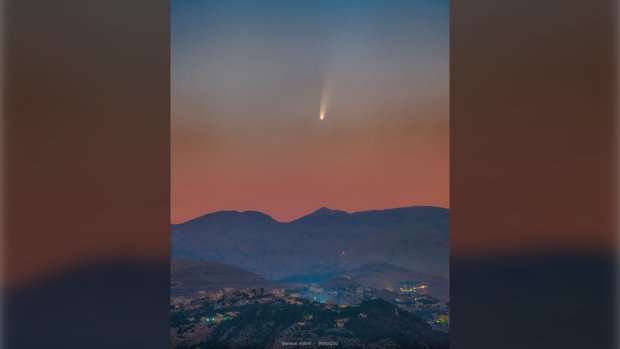TORONTO -- Early risers in the northern hemisphere will be treated to a view of a recently identified comet, which has suddenly become visible to the unaided eye, as it hurtles towards Earth.
Comet NEOWISE – technically called C/2020 F3 (NEOWISE) – was first discovered on March 27 by the Near Earth Object Wide-field Infrared Survey Explorer (NEOWISE) space telescope launched by NASA in 2009.
At the time, astronomers were unsure if the comet would meet a similar fate to other comets before it, such as Comet ATLAS and Comet SWAN, and break apart as it travelled close to the sun and warmed up.
However, it appears Comet NEOWISE survived its closest approach to the sun late last week and is now making its way closer to Earth before it is expected to return to the outer solar system, according to NASA.
The space agency said the comet has become one of the few “naked-eye comets” of the 21st century after it “suddenly” became visible to the unaided eye this week.
“Word spread quickly, and the comet has already been photographed behind many famous sites and cities around the globe,” NASA said in the caption of a photo of Comet NEOWISE passing over Lebanon on Sunday, which they shared as their “Astronomy Photo of the Day” on Tuesday.
Although the future brightness of the comet “remains somewhat uncertain” because there’s still a chance it may break apart and therefore dim, NASA said the comet is likely to continue to be visible in the early morning sky this week and in the early evening sky next week.
According to NASA solar system ambassador Eddie Irizarry, Comet NEOWISE is visible at dawn now, but it will be at its highest in the dawn sky around July 11. The comet may be a little tricky to catch, he said, because it will be set against the brightening sky in the northeastern horizon, as opposed to a dark night sky.
Malcolm Park, an astro-photographer who has taken photos of the comet in Ontario, said the comet rises at approximately 3:15 a.m. in the morning sky and becomes more visible between 4 a.m. and 4:30 a.m.
“If you're going to look in the morning, which is over the next week or so, you want to look in the northeast sky, you want a nice clear horizon, and hopefully, very little cloud because the cloud will obscure the detail in the tail,” he told CTV News Channel on Tuesday.
However, Comet NEOWISE may become easier to spot later in the month after it gradually dips below the horizon and reappears in the early evening sky around July 12 to 15. When that occurs, it will then be visible at dusk (just after sunset) in the low northwest horizon, Irizarry said.
“If the comet remains relatively bright, it might be easier to see in the second half of July during evening dusk, because, at that time, it will appear somewhat higher in the sky,” he said.
Although it may be difficult for the average stargazer to spot the comet in the early mornings right now, some skilled photographers have already managed to capture the speeding comet and its streaking tail.
I have a strong dislike of early mornings—but so worth it today because wow is that comet beautiful! C/2020 F3 (NEOWISE) I was at Sunset Crater by 4AM. It was an easy naked-eye object, but really rewarding through binoculars. Last pic is closest to naked eye scale.#neowise pic.twitter.com/1I0Cx2fZQJ — Jeremy Perez (@jperez1690) July 5, 2020 Comet NEOWISE and the city of Toronto, Ontario, Canada ! I was up really early for this shot. It's not often that we get the opportunity to see or photograph a comet of this brightness and with a tail. I hope you like it! https://t.co/BFyxFFw2DE pic.twitter.com/sGZBiEVryM — Kerry LH (@weatherandsky) July 5, 2020
Even though some people have been able to spot the Comet NEOWISE without any instruments, Irizarry said most skywatchers would benefit from the use of binoculars or even a good camera.
Irizarry has also published several illustrations detailing the comet’s location in relation to different constellations so interested viewers know where in the sky to look.
Park also recommended using binoculars to view the comet, which he described as a “unique” opportunity.
“There are comets all the time, but they are not always visible to the naked eye or with binoculars in this case, and it's the pleasure of looking up at the night sky and seeing in the stars, something that's a little different and it represents a different kind of object that's out in the solar system.
On the chance the comet fades later in the month, Irizarry said it’s still a worthwhile endeavor for people to wake up early to try to catch it while it’s in the morning skies.
“It’s still a good idea to get up early in the morning this week and try for a glimpse of comet NEOWISE while it’s still relatively bright, just in case it gets fainter later in the month,” he explained.
Park, too, encouraged people to go out and try and see it sooner than later.
“We can't guarantee you that in a month or in six weeks, it'll still be as bright, although the possibility exists, it could still be visible in about a week to 10 days,” he said.

_Tao on July 8th, 2020 at 02:42 UTC »
It’s interesting that because this comet is usually black like charcoal, it was basically invisible up until a few days ago when it started shooting off gases that reflect light
roxy_dee on July 8th, 2020 at 02:36 UTC »
I’m so excited!!! I was too young to remember Hale-Bopp so this is very cool
muhammadshoaib2002 on July 8th, 2020 at 02:21 UTC »
I am hyped for next week to see it in early evening hopefully the brightness should be same as this week